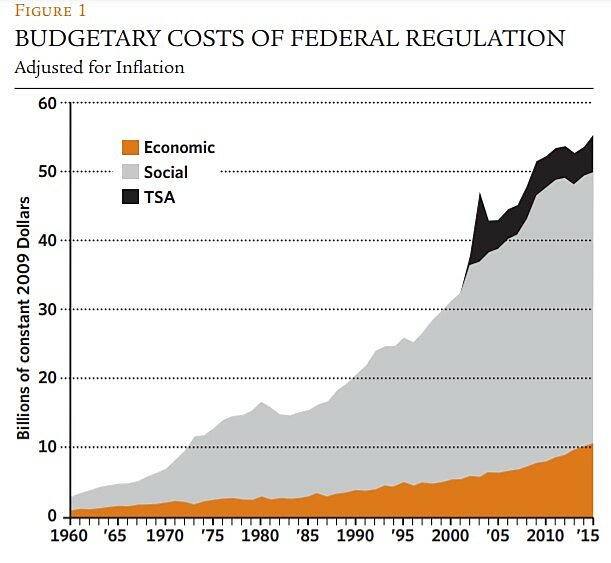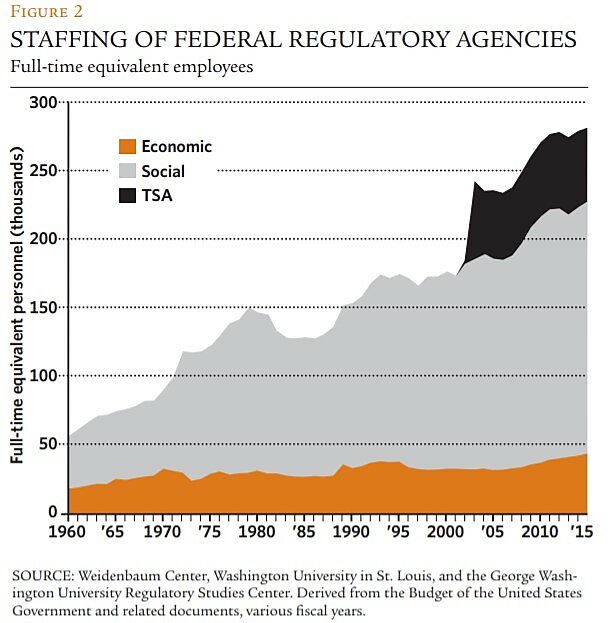Our most recent report examines the requested budget outlays in fiscal year 2015 as well as estimated outlays for FY 2014. It also provides 56 years of data on annual outlays and staffing, from FY 1960 to the present. Those data reflect the on-budget costs of regulation and cannot inform analysts about the benefits regulations may convey. They also do not reflect full costs, as regulations impose social costs beyond the direct tax dollars spent to write and enforce them. An assessment of the full cost would not only calculate businesses’ and individuals’ costs associated with compliance, but also the loss of economic opportunities and choices available to individuals and organizations.
Despite those limitations, the time-series data on expenditures and staffing of federal regulatory agencies presented in the regulators’ budget report offer a useful proxy of the size and growth in regulations that American businesses, workers, and consumers must follow. This information can serve as a barometer of regulatory activity, providing policymakers and analysts with useful insights into the composition and evolution of regulation over time.
Overall, this year’s report finds that the regulators’ budget continues to grow at a modest pace. The proposed budget for regulatory activities in FY 2015 is $60.9 billion (in nominal dollars), a real (inflation-adjusted) increase of 3.5 percent above estimated FY 2014 outlays. (See Figure 1.) The FY 2014 regulators’ budget of $57.8 billion is 2 percent larger than FY 2013 regulatory agencies’ outlays of $55.9 billion. The proposed budget also requests an increase in federal regulatory agency personnel of 0.8 percent in FY 2015, following an estimated 2.0 percent increase in FY 2014. (See Figure 2.)
One of the most interesting (though not surprising) findings of our analysis is that, while tight budgets are constraining regulatory spending at many federal agencies, those that are at least partially funded by fees on the entities they regulate are able to support substantial increases in regulatory outlays and staffing. For example, while the Environmental Protection Agency’s outlays shrank by almost 4 percent in 2014, the Food and Drug Administration’s budget grew by more than 29 percent. The Consumer Financial Protection Bureau’s spending increased 33 percent in 2014 and outlays of both the Patent and Trademark Office and the Securities and Exchange Commission grew by more than 10 percent. The growth in spending and staffing at those agencies appears to reflect not only the increased scope of their regulatory activities, but a greater ability to finance those activities from revenue sources that are less affected by congressional spending limits.
This year’s analysis also documents some interesting long-term shifts in regulatory spending patterns, including a trend in which overall outlays devoted to economic regulatory activities, including price, quality, and entry regulation, are increasing at a faster rate than those aimed at social regulatory activities such as environmental, safety, and health issues. This reverses a trend that began in the 1970s away from economic regulation of private-sector activities, and would likely be more dramatic if our data included agencies of the Department of Health and Human Services that pursue economic regulation of health insurance markets pursuant to the 2010 Patient Protection and Affordable Care Act. While the staffing and outlays devoted to these regulations do fit the criteria for inclusion in the regulators’ budget report, the 2015 proposed budget did not allow us to distinguish between resources devoted to regulations that affect private-sector behavior (covered in the report) and those that affect entitlement spending (not included). This trend is worth watching because economic theory and empirical evidence suggest that the costs of economic types of regulation often outweigh the benefits.


